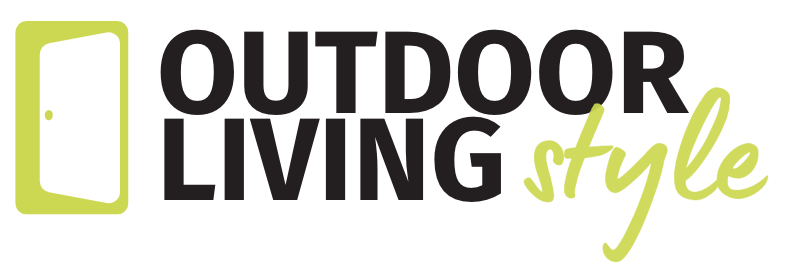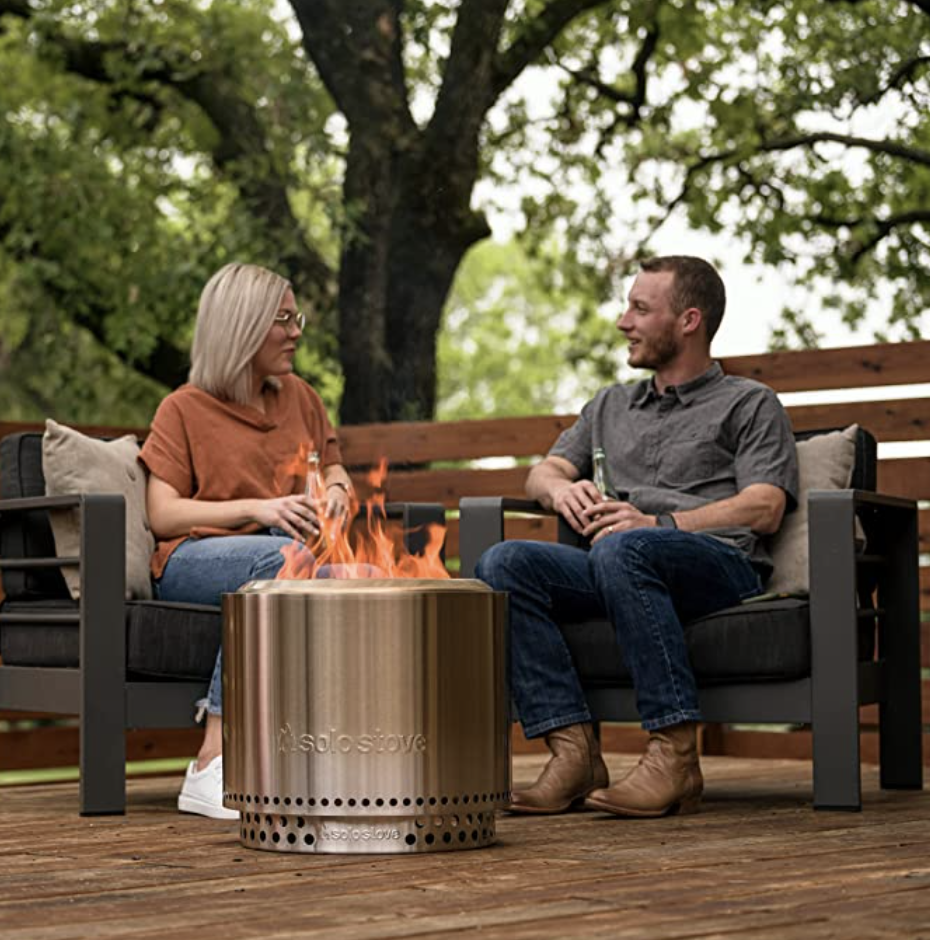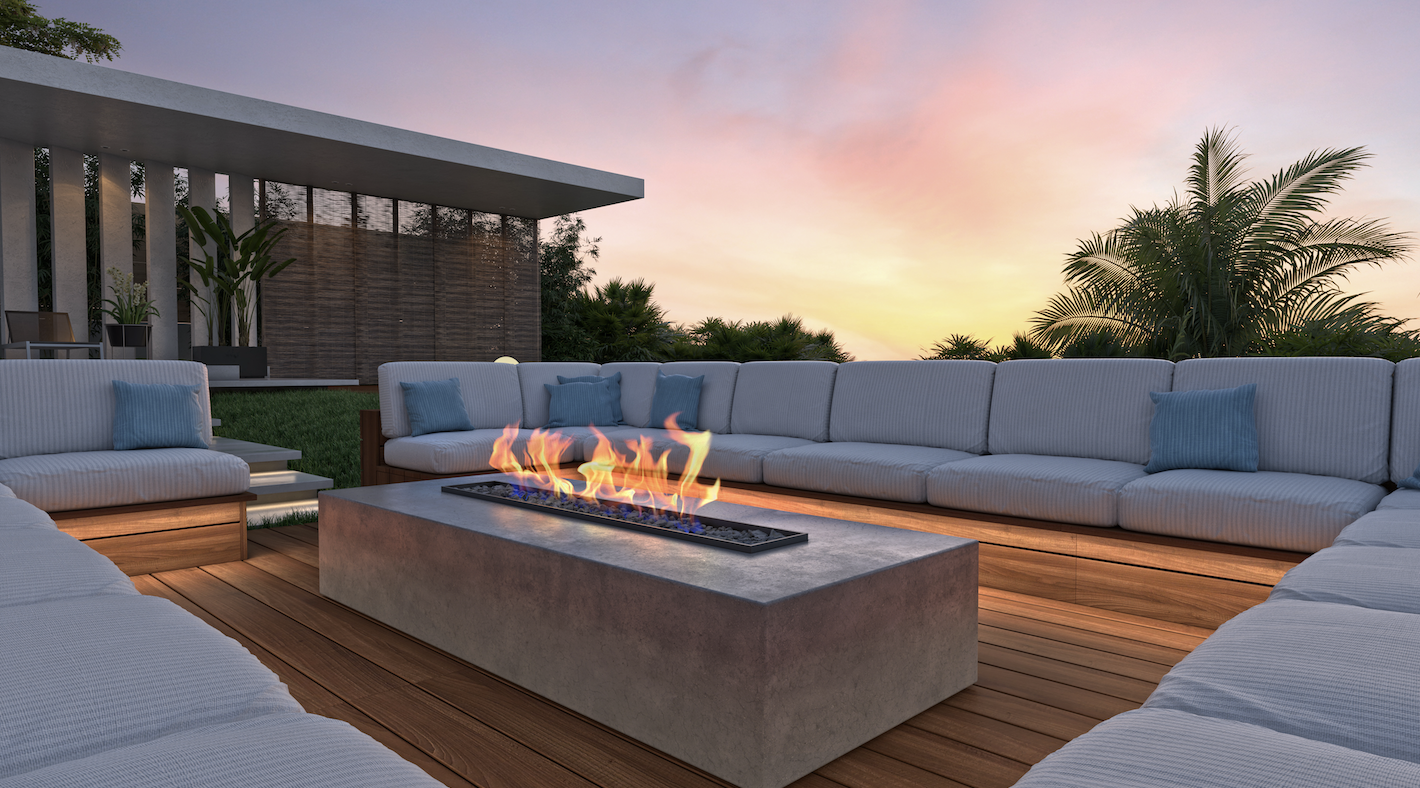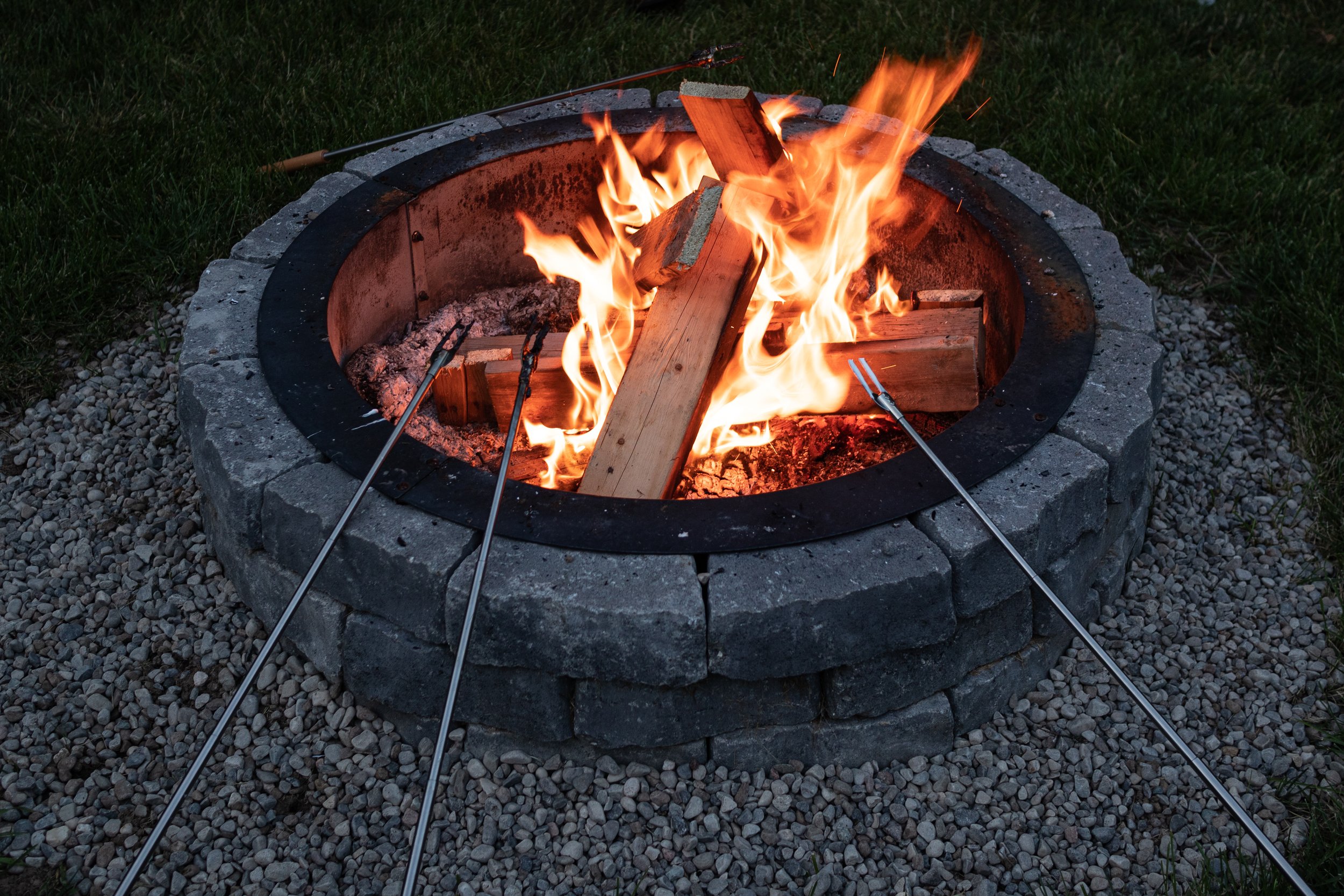The Ultimate Guide to Fire Pits: How to Make A Dramatic Improvement in Your Outdoor Living Space
The fire pit is often the favorite element of an outdoor living space. But how do you ensure yours will be perfect for your home and needs? Enter our ultimate guide to fire pits. Whether you crave the nostalgic and rustic feel of a campfire, or you’re dreaming of a sleek & modern clean-lined beauty, you’ll want to make sure you check a few boxes to make sure you create a functional, and beautiful, outdoor space.
Wondering why so many backyard landscape designs include a fire pit area? Here’s why.
Beyond providing warmth and ambience for your outdoor living space, properly designed and installed fire pit areas also provide an activity—so it’s a two for one with beauty and function. Kind of like the heart of the indoor home is the kitchen, fire brings family, friends, and neighbors together for conversation, marshmallow roasting, music, and stories.
But another very important benefit that many homeowners don’t think about while planning their backyard landscape, is how a fire feature, much like an outdoor heater, extends the time you can use your investment each and every year. A well-designed, professionally installed outdoor living space can be a large investment, especially if a pool is included. For those living in regions like the Northeast and Midwest, the use of that investment is cut short by Old Man Winter. But having a well-placed fire feature can easily extend the outdoor living season by upwards of 4 weeks— a positive return on the relatively small portion of the overall investment for sure!
Initial planning considerations…
In its most simplistic state, a fire pit is a depression or vessel where a fire can be sustained. Not rocket science there, huh? But just because fire is old school and primitive doesn’t mean yours has to be—unless rustic, back-in-the-day vibes are your thing in which case, by all means, break out the tire ring. But for most homeowners planning a luxury backyard, you can still enjoy the dance of the flames, but with style and convenience from…this century.
Thing is, with so many different fire put options to choose, homeowners can feel a bit overwhelmed during planning. We get it. Let’s boil it down to a few key points…
Aesthetics. Do you prefer a rustic look? Sleek and modern? Do you prefer organic shapes (round and oval) or geometric shapes (square and rectangular)? Do you want your fire pit to integrate seamlessly into the outdoor living space, or do you want it to be a focal point that embraces its individuality? Usually the first step in getting some answers to these questions is to choose a places—or places—of inspiration. Established landscape designers will share links to their online portfolios, as well as popular sites like Houzz, Pinterest, Instagram, and good ole’ Google images.
Placement. Next, think about how you want your fire pit to fit into the space and how you will use it. Will it be a simple place for a few people to gather and gaze at the view? Will it be where party goers gather with drinks in hand? The fire pit can either become a focal point of your backyard or a destination where serenity rules. These answers should be found solely through an exploration of your needs and wants for using this special spot.
The Big Three: Finally, you’ll need to make decisions on the nitty gritty of the final feature including:
Fuel type: The two main fuel sources for backyard fire puts are wood and gas (natural or propane). There are pros and cons to both, which we dive into below in more detail.
Materials: Fire put surrounds can be constructed using pre-case concrete wall stone like those options from Unilock, Techo-Bloc, and Belgard, or natural stone which is not man-made, or finished concrete.
Installation Method: Hire a contractor to design and build you a custom fire pit, or go prefab—that’s the question. Most professionally design and installed backyard landscapes will include a custom fire pit, built on site by a crew. That said, as of late, the market has been flooded with freestanding fire put units such as those from Breeo and Solo Stove. While these types of products were seldom found in backyards designed by professional landscape pros in the past, they are becoming much more popular for their ease of use and portability. Learn more here:
FEATURED PRODUCT:
The Solo Stove Bonfire Smokeless Fire Pit
The Bonfire is the mid-sized model of smokeless fire pits from Solo Stove. With a diameter of 19.5 inches and a weight of 20 pounds, this fire pit can produce an incredible amount of heat for an outdoor space while still remaining portable.
What Type Of Fire Pit Is Best?
The best fire pit is the one that is best suited for your use case and lifestyle. The best, most detail-oriented landscape designers and design/build firms take a lot of time upfront, exploring the client’s wishes and working to understand how each potential project element would be used. Before a digital pencil every hits a screen, their job is to truly understand what you as the client actually needs vs what is often included in “most” outdoor living projects. Do you entertain lots of people regularly? Do you have small, active children? Are you recently retired and traveling a lot? What hours of the day will your outdoor spaces get the most use? Questions like these help a landscape designer to understand what fire pit is best…for you. But let’s explore that in a bit more detail based on the vast experience of the Outdoor Living Style team.
Built-in, Custom Fire Pits
For most full-scale outdoor living projects—ie those that include outdoor kitchens, shade structures, pools, etc—a built-in, permanent fire pit—or even outdoor fireplace—is almost always the fire feature of choice. These features help outdoor living spaces feel…intentional and resort-like.
Built-in fire pits that are constructed on-site can be any size, and as simple or complex as the space calls for. One of the more common construction styles uses sturdy and easy to install basic concrete blocks as the main structure of the fire pit, which is then clad with a beautiful natural stone or manufactured stone veneer.
Pre-assembled Fire Pits
assembled fire pits can include masonry blocks (usually concrete blocks), metal, or poured concrete. The upside is that you can enjoy your fire pit the day it arrives, assuming that natural gas has already been hooked up to the area if that’s your fuel of choice. The downsides include added shipping costs and you don’t have the ability to customize the fire pit.
Freestanding, Portable Fire Pits
An easier, less expensive option for bringing the heat to the backyard is the trending product category of portable fire pits—in particular the smokeless fire pit craze. Products like Solo Stove and the Breeo X19 options are leading the way for this less committal way of adding a little excitement to the back patio.
FEATURED PRODUCT:
The Breeo X Series 19
The smallest version of this line of smokeless fire pits. While the inner chamber of the fire pit is 19 inches across, the total diameter is 22 inches. This makes the Series 19 extremely versatile in warming up a small patio where space is at a premium.
More on fuel…
The oldest and most common fuel for a fire pit is wood. This fuel will create an incredible amount of heat and light, some of the basic elements that kept our ancestors safe and enabled civilizations to begin. The sounds, visuals, smells, and feelings of a wood fire are practically inscribed in our DNA and can provide a great deal of enjoyment for everybody, especially anyone who loves to tend the fire. Wood provides the crackling of water boiling and bursting, the fascinating images of burning embers, the comforting smells of burning wood, and of course warmth. And, you can cook over a wood fire provided that you use the right wood (fruitwoods are the best). The downsides include limited locations, smoke (unless you opt for a smokeless fire pit, of course), need to constantly tend the fire, flying embers, and the mess of firewood.
Natural gas fire pits may not be as stimulating to the senses as wood fire pits, they have several important benefits. They provide consistent heat (though less than wood fire pits) and the ability to instantly shut off the flames. Some types let you adjust the flames, but not all have this feature. Natural gas and propane fire pits also do not produce the smoke or ash. The downsides to a natural gas fire pit are the initial expense of running a gas line to the fire pit location, as well as the ongoing cost of gas.
Propane fire pits offer the flexibility of location: as long as you’re willing to haul a propane tank to the fire pit, you can place it anywhere you like even if it’s far from the house: overlooking a great view, or in a secluded corner. The downside of propane fire pits is the need to disguise the propane tank. For this reason, many propane fire pits are taller than natural gas fire pits, effectively becoming “fire tables.” In fact, many propane fire pits will feature more generous tops where you can put a place setting and enjoy an actual meal with an amazing centerpiece).
It’s not recommended that you cook on a gas or propane fire pit since lava rock or fire pit glass is very difficult to clean.
Where Should A Fire Pit Be Located?
As they say in real estate, “location, location, location.” The same applies to your fire pit. The location of your fire pit is not only essential for your enjoyment of your outdoor living space, but for safety. Let’s cover the basics of the space needed for the ideal spot to put your fire pit, whether you choose wood or natural gas or propane.
All fire pits (wood-burning and gas) need the following:
Level Surface: Every fire pit needs to be located on a level surface that covers the entire fire pit space. This primarily ensures that the burning materials will be as stable as possible. It will also help to prevent accidents caused by someone losing their balance as they walk around the fire pit. Even if the surroundings are sloped or the feature is set higher or lower, the fire pit and its surrounding seating or standing area need to be level.
Heat-resistant Base: Every fire pit needs to have a stable, heat resistant base for safety. Although gas fire pits don’t put out as much heat as a wood fire, you still want to avoid having certain materials in direct contact with the fire pit including grass, wood, or plastics that could melt. Wood fire pits need a layer of sand as well as masonry blocks at the base if they’re installed on bare ground. They can also be retroactively installed on an existing stone or paver patio. If you want your gas fire pit to be located on a deck, open porch, or surrounded by grass, then a suitable fireproof barrier needs to be utilized: this could be as simple as laying patio pavers or a circle of gravel around the fire pit.
Space around the fire pit for seating. This is surprisingly somewhat overlooked in many designs. The amount of space needed around a fire pit is fairly substantial: 6-10 feet from the perimeter of the fire pit all the way around will allow plenty of space for seating and walking. Reducing the space around the fire pit could result in a space that is uncomfortably crowded. The surrounding space you need will depend partly on the location of the fire pit and if you opt for individual chairs or permanent seating; if you want to seat more people than normal, the chairs would need to be further from the flames which means expanding the circle. Permanent seating such as a seat wall can act to define the space as well as provide seating (people could get cozy next to each other but you won’t be able to add chairs to the mix).
Locations and Safety Considerations for Wood Fire Pits
For best experience and safety with a wood fire, place it in a location that’s as out of the wind as possible. A wood fire pit needs to be located at least 10-20 feet away from buildings, structures, trees, plants (including grass), or other flammable elements. While the fire will be tightly controlled and safe most of the time, it is quite possible that the flames can jump and spark a new fire. This is especially possible with strong gusts of wind.
For safety, create a buffer zone of no flammable materials at least 10-20 feet around the fire pit feet to eliminate the threat of fire from errant sparks.
Wood fire pits should not be located on pool decks, to avoid the mess of splinters and ash.
Locations and Safety Considerations for Natural Gas and Propane Fire Pits
The safety requirements for a natural gas or propane fire pit are less stringent than for wood-fueled fire pits because natural gas and propane don’t generate as much heat, the flames are consistent (and cannot be turned into a roaring bonfire), and feature instant shut-offs.
Natural gas or propane fire pits can be located anywhere —even under a pergola, porch, pavilion, or under a deck. They can also be placed immediately adjacent to flammable elements like a privacy fence or trees.
Natural gas or propane fire pits can also be located adjacent to the pool, which is not recommended for wood-fueled fire pits. Swimming and warming up by a fire pit go hand in hand. Whether the swimming is happening in the heat of the summer day or a particularly chilly evening, the fire pit will keep pool goers more comfortable. This location also offers an opportunity to use your pool area even once the pool has been closed down for the season.
Great Locations for Fire Pits
Given these safety considerations, hopefully you’re envisioning the perfect spot for your fire pit. Here are some ideas:
Fire pits are perfect for a little piece of solitude away from the action, in a far corner of your landscape. Place a fire pit in that one piece of your backyard with the least amount of interference from the outside world. Surround it with a few comfortable seats so that a few close friends or family members can enjoy some peace and quiet together with just the gentle flickering and crackling of flames to keep them company. For the most amazing experience, surround the space on two sides with a privacy wall. A wood or propane fire pit could be ideal for creating a secluded getaway.
Fire pits can also be key focal points at the center of the action. The fire pit is the perfect feature to show itself off as the centerpiece of your patio or deck. A fire pit is the perfect place for people to gather, whether it’s during a big party or a quiet get-together. Place your fire pit at the center of everything and let it dictate the surrounding design, complete with masonry continuity and sight lines that lead to the fire. Any fuels could be suitable for a fire pit that’s the center of attention.
Now that you’ve thought about the best location for your fire pit, let’s talk design.
What Shape of Fire Pit Is Best?
If the intent of your fire pit is to gather around the fire and stay warm, then choose a round fire pit which will give everyone equal access to the heat. Heat disparity is especially noticeable if you're burning wood. Wood fire pits are most often round, and less commonly square: and round is better. The hottest part of the fire will always be in the center. With a square fire pit, someone sitting at the corner of the fire pit could have a much different experience than someone who is sitting along the side and therefore closer to the center of the flames.
Natural gas or propane fire pits come in round, oval, square, or rectangular shapes. This gives you plenty of design options especially if the intent is to make your fire pit a focal point.
What Is A Good Size For A Fire Pit?
When you are building a fire pit, size matters. A large wood fire pit can warm up a crowd, but it also could be tempting for certain people to build it up to a bonfire. A petite fire pit could be just the ticket for an otherwise unused corner of the patio but the size will limit the number of people who can enjoy it. The bigger the fire pit, the more people you can seat around it; but keep in mind that you’ll need to factor in a considerable amount of space around the fire pit for seating and traffic flow.
Some of the most popular round fire pit circumferences are between 36 inches and 44 inches. The height of this pit is often from 12 to 20 inches to allow heat to best radiate outwards. The surrounding area should be 6-10 feet from the perimeter of the fire pit to allow for comfortable seating and safe movement. In total, this could amount to a fire pit circle that’s anywhere from 9 feet to 14 feet in diameter.
This is a big space commitment but if space is tight, you could locate a very small gas fire pit in a corner with seating fanning out around it (but not all the way around).
How Many Layers Should A Fire Pit Have?
The number of masonry layers of the fire pit will depend on the height, but it’s important to consider the combination of the above ground structure and the below ground structure. Inside the fire pit itself, there also needs to be a layer of fireproof materials between the flames and the ground below: this includes a 6” layer of sand, as well as a layer of masonry blocks. The combination of these two layered systems will make your fire pit safe and help it last far longer.
The typical fire pit is 12-20” high above ground; depending on the types of blocks you’re using, this could be three or four layers plus a cap stone layer for a clean, finished look.
What Should You Put Under a Fire Pit?
It may surprise you that one-third to half of the actual structure of a wood-fueled fire pit is actually below the ground: a 6” layer of sand which will help dampen the heat that radiates downward.
What Do You Put In The Bottom Of A Fire Pit?
For wood fires, the fireproof layers beneath the fire itself are essential for safety. A fire pit will slowly radiate lots of heat beneath the ground, so it’s important that the materials you use will dampen the heat. Start with a layer of sand 6 inches deep at the very bottom of a wood fire pit, and a layer of bricks or concrete blocks on top of the sand. These blocks do not have to be decorative, since they won’t be adding to the visual field. Putting blocks on top of the sand will also make ash cleanup easier.
For natural gas and propane fire pits, the key is the materials within the fire pit itself: gravel, lava rocks, or fire pit glass. These will not only effectively keep the heat from going downwards, but they will also make a beautiful and interesting texture beneath the flames.
How Do I Build A Cheap Fire Pit?
The cheapest kind of fire pit will use wood as its fuel. At its most basic, the only components of a wood fire pit are going to be a layer of sand, the various masonry blocks and cap stones. With such a basic structure, you can make a very cost-effective fire pit. You may see various videos or articles online of how a DIY homeowner built a wood fire pit for under $100.
Building a natural gas fire pit involves the expertise of an experienced professional to run the gas line. Once the gas line is in place, however, you can DIY the structure.
Given the initial cost, you may be tempted to go as cheap as possible and the best way to do that is to use concrete blocks that are designed for retaining walls. Many are shaped with a tapered back, which makes it easier to create a circular fire pit. And don’t forget a cap stone! The more generous the cap stone, the more finished your fire pit will look — and you’ll be able to comfortably rest your feet on it to warm up on a cold day.
Keep in mind that the higher your budget for masonry materials, the more visually attractive your fire pit will be. And since this is a one-time expense, it could be worth it in the long run to splurge a bit and buy nicer blocks and cap stones.
What Do You Need for a Backyard Fire Pit?
For a wood fire pit, you’ll need sand as the bedding material, concrete blocks for the interior floor, natural stone or concrete blocks for the structure, cap stones for a finished look, and mortar. You’ll also want a sheltered spot near the fire pit to store firewood and keep it dry. Depending on the location of the fire pit, you may also need gravel or patio pavers to surround the fire pit (to create your buffer zone). This won’t be necessary if you’re placing your wood-fueled fire pit on an existing natural stone or paver patio.
For a natural gas fire pit, you’ll need a gas line in addition to the fire pit materials which include masonry and fire glass or lava rock. Propane-fueled fire pits are typically pre-built. You’ll need to add lava rock or fire glass, and the only recurring expense will be propane.
Is An Outdoor Fire Pit Worth It?
In a word, yes!
Other than outdoor kitchens, only fire has the ability to get people to spend more time outside. And as we’ve mentioned, you’re paying for the space anyway, so doesn’t it make sense to enjoy it not just in the balmy days of summer, but even year-round?
Any type of fire pit will make spending time outside much easier and much more enjoyable. A fire pit will make gatherings in cooler weather possible. A fire pit will provide heat and light to an outdoor living space. Even when not hosting a fire, a fire pit can be a gorgeous addition to your landscape.
With the most basic fire pits running for as little as fifty dollars or as high as several thousand, the worth of your fire pit will be dictated by aesthetics. A fire pit that’s built for several thousand dollars by professionals isn’t necessary for a campfire and some s’mores. The same extravagant fire pit, however, can be the hallmark of a luxurious entertainer’s paradise. Either way, a fire pit will always be worth it.









